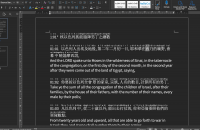Hi Thessaliad,
thanks for the font. As you surely know, it's too bad the pinyin for each character isn't always the same. That would have made the implementation of ruby text a lot simpler. A good piece of pinyin annotation software needs to have a large dictionary and AI to get a low error rate. In some cases, the pinyin will still be wrong, because the computer still can't understand the meaning of sentences at a pragmatic level. In search of a good example for this problem, I found the following on Wikipedia:
"The sentence "You have a green light" is ambiguous. Without knowing the context, the identity of the speaker or the speaker's intent, it is difficult to infer the meaning with certainty. For example, it could mean:
- the space that belongs to you has green ambient lighting;
- you are driving through a green traffic signal;
- you no longer have to wait to continue driving;
- you are permitted to proceed in a non-driving context;
- your body is cast in a greenish glow;
- you possess a light source which radiates green; or
- you possess a light with a green surface."
I would guess that in the writing of a Chinese book, the effort needed to go over the ruby text isn't that great compared to the writing of the book itself, so the gold standard for good ruby text probably still is editing done by humans, perhaps aided by a computer for the initial annotation.
Did you know this site? It looks all right:
Adds inline and pop-up annotations with pronunciation in Pinyin or Zhuyin and English definitions to Chinese text or web pages.

mandarinspot.com
This app "Chinese Annotator" for 1 USD also looks good, with positive reviews:
A Chinese ePub reader to assist you in reading Chinese characters. After importing an ePub, you can add Pinyin and English on to the text in a 3-line format. After annotating the text in this way, you can then mark on a word by word basis which definitions you already know and which characters...
apps.apple.com
Cheers, Shun


